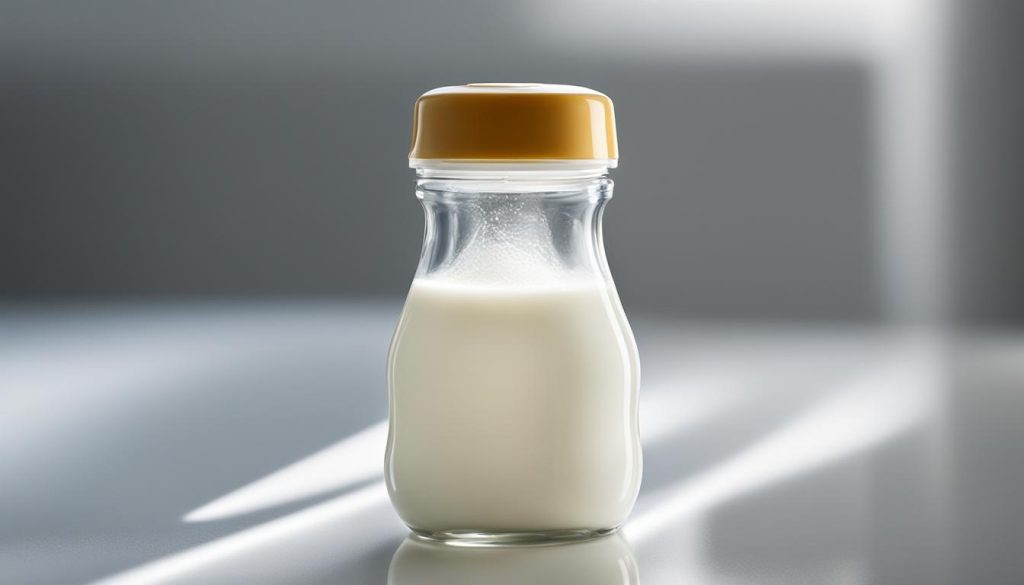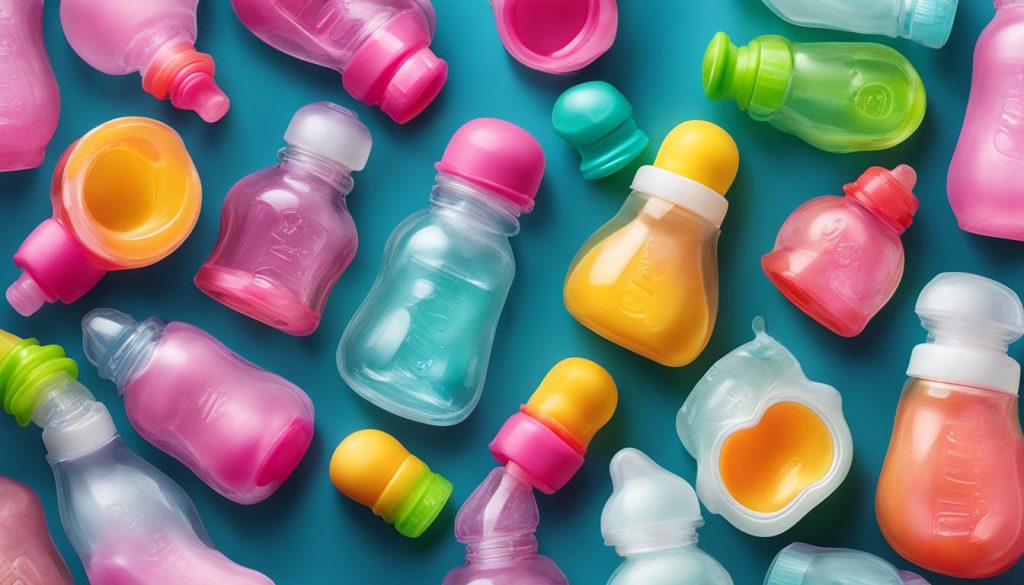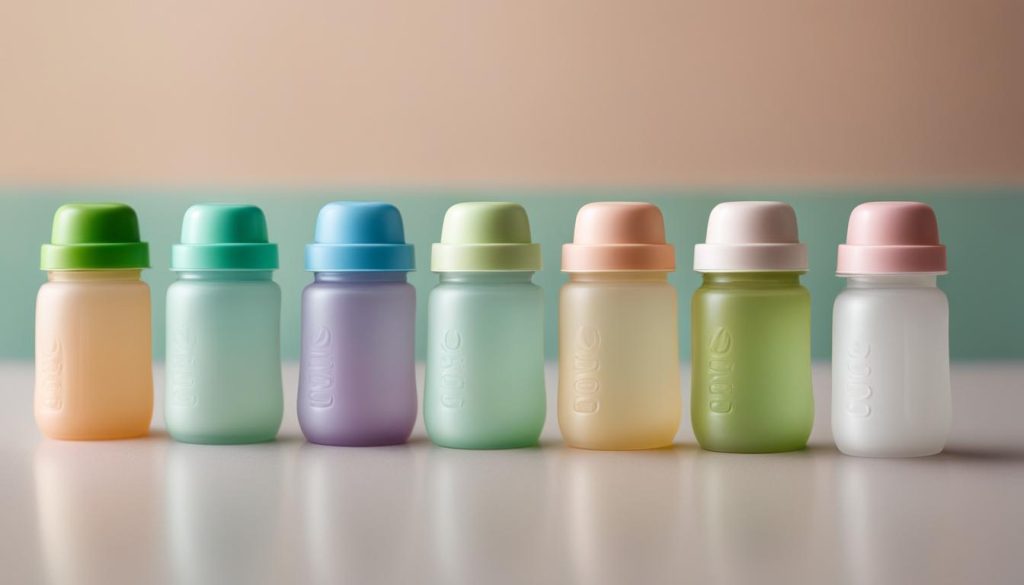When it comes to choosing the right baby bottle, there are various types to consider. Understanding the different options available is important for enhancing your infant’s feeding experience. Whether you’re looking for wide neck baby bottles, standard neck baby bottles, vented baby bottles, or anti-colic baby bottles, this article will explore the different types of baby bottles and help you make an informed decision.
Exploring Baby Bottle Shapes and Sizes
When it comes to choosing the right baby bottle, the shape and size are important factors to consider. Different bottle shapes can have an impact on reducing gas and fussiness during feeding. The two main types of baby bottle shapes are curved bottles and standard bottles. Let’s explore the benefits and considerations of each shape.
Curved Baby Bottles
Curved baby bottles are designed specifically to reduce the swallowing of air during feeding. The curved shape allows the milk to flow smoothly, minimizing the amount of air your baby ingests. This can help to prevent issues such as colic and gas. Curved bottles are often recommended for babies who are prone to fussiness or have difficulty with proper digestion.
Standard Baby Bottles
On the other hand, standard baby bottles have a straight shape and are the most commonly used type. While they may not have the same anti-colic benefits as curved bottles, they are still a popular choice for many parents. Standard bottles are versatile and widely available, making them easy to find and convenient to use.
When it comes to bottle size, it’s important to choose one that suits your baby’s needs. Smaller bottles, typically around 4-5 ounces, are ideal for newborns who have smaller appetites. As your baby grows and starts to consume more milk, larger bottles ranging from 8-9 ounces or even more may be necessary.
Overall, both curved and standard baby bottles have their advantages, and the choice ultimately depends on your baby’s preferences and feeding habits. It’s always a good idea to try different shapes and sizes to see what works best for your little one.
| Bottle Shape | Advantages | Considerations |
|---|---|---|
| Curved | Reduces swallowing of air, helps prevent colic and gas | May be more expensive, limited availability |
| Standard | Widely available, versatile, convenient to use | May not have anti-colic benefits |
Table: Comparison of Baby Bottle Sizes
| Bottle Size | Ideal Age Range |
|---|---|
| 4-5 ounces | Newborns |
| 8-9 ounces or more | Older babies |
Comparing Materials Used in Baby Bottles
When it comes to choosing the right baby bottle, one of the key considerations is the material from which it is made. There are three common options to choose from: glass, plastic, and silicone. Each material has its own unique features and benefits, so it’s important to understand the differences in order to make an informed decision.
Glass Baby Bottles
Glass baby bottles are known for their durability and ability to withstand high temperatures. They are a popular choice among parents who prefer a chemical-free option, as glass is non-toxic and free from harmful substances like BPA and phthalates. Additionally, glass bottles are easy to clean and maintain, as they can be safely sterilized in boiling water or a bottle sterilizer.
Plastic Baby Bottles
Plastic baby bottles are lightweight, making them convenient for on-the-go parents. They are also shatterproof, which reduces the risk of accidents and breakages. Plastic bottles often come in a variety of colors and designs, adding a fun element to your baby’s feeding routine. However, it’s important to choose BPA-free plastic bottles to ensure the safety of your little one.
Silicone Baby Bottles
Silicone baby bottles are a popular choice for their soft and flexible nature. They are lightweight and easy to handle, making them suitable for both babies and parents. Silicone bottles are also durable and resistant to high temperatures, making them easy to clean and sterilize. Additionally, they are free from BPA and other harmful chemicals, providing a safe option for your baby’s feeding.
When selecting a baby bottle material, consider factors such as your baby’s preferences, ease of use, and safety. It’s important to choose a material that meets your needs and provides a comfortable feeding experience for your little one.
| Material | Features | Benefits |
|---|---|---|
| Glass | Durable, non-toxic, easy to clean | Chemical-free, can be sterilized, long-lasting |
| Plastic | Lightweight, shatterproof | Convenient for travel, variety of designs |
| Silicone | Soft, flexible, easy to clean | Lightweight, safe, resistant to high temperatures |
Understanding Different Nipple Types
When it comes to baby bottle nipples, there are several factors to consider, including size, shape, and material. The right nipple can make a significant difference in your baby’s feeding experience. Let’s explore the various options available and how to choose the perfect nipple for your little one.
Sizes
Baby bottle nipples come in different sizes to accommodate the growth and development of your baby. The sizes typically range from slow flow (intended for newborns) to fast flow (suitable for older babies). It’s essential to consider your baby’s age and feeding abilities when selecting the appropriate nipple size. Using the right size will help prevent choking or frustration for your little one.
Shapes
Nipple shape is another crucial factor to consider. Some nipples have a traditional shape, resembling a mother’s breast, while others are designed with a wider base or specialized shape to promote proper latch and reduce nipple confusion for breastfeeding babies. It’s important to observe your baby’s preference and sucking style to determine which shape works best for them.
Materials
When it comes to nipple materials, there are generally two options: silicone and latex. Silicone nipples are durable, easy to clean, and resist discoloration. They are also less likely to cause allergic reactions. Latex nipples, on the other hand, are softer and more flexible, simulating the natural feel of a breast. However, latex nipples may break down faster and may not be suitable for babies with latex allergies.
Understanding the different nipple types and considering your baby’s age, feeding style, and preferences can help you choose the ideal nipple for a comfortable and enjoyable feeding experience.
| Nipple Type | Advantages |
|---|---|
| Standard Nipple Shape | – Resembles a mother’s breast – Suitable for most babies – Offers a familiar feel |
| Wide Base Nipple | – Promotes proper latch – Reduces nipple confusion |
| Orthodontic Nipple | – Supports oral development – Mimics the shape of a mother’s nipple during breastfeeding |
| Preemie Nipple | – Smaller size for premature babies – Controls milk flow for easier feeding |
Tips on Bottle Maintenance and Sterilization
Maintaining clean and sterilized baby bottles is essential for your little one’s health and safety. By following these tips on cleaning baby bottles, sterilizing them, and replacing bottle nipples, you can ensure that your baby’s feeding experience remains hygienic and worry-free.
Proper Cleaning Techniques
To effectively clean baby bottles, start by disassembling them. Separate the bottle, nipple, collar, and any other detachable parts. Rinse all components with warm water to remove any leftover formula or breast milk. Then, place them in a clean basin or use a bottle brush to scrub the interior and exterior surfaces with mild soap or baby bottle detergent. Scrub the nipple with a specialized nipple brush, paying attention to the nooks and crannies. Rinse all parts thoroughly with hot water to remove any soap residue.
Sterilization Methods
In addition to regular cleaning, sterilizing baby bottles is crucial to eliminate harmful bacteria. There are different methods you can use to sterilize baby bottles:
- Boiling: Submerge all parts in a pot of boiling water for at least 5 minutes. Ensure that the water covers all the components to effectively kill germs.
- Steam Sterilizers: These devices use steam to eliminate bacteria. Follow the manufacturer’s instructions for proper usage.
- Microwave Sterilizers: Designed specifically for sterilizing baby bottles, these containers use steam generated by the microwave. Again, carefully read and follow the instructions provided by the manufacturer.
- Chemical Sterilizing Solutions: Some parents opt for using sterilizing solutions or tablets specifically formulated for baby bottles. These solutions usually require dilution in water, followed by soaking the bottles and accessories for a specified period.
Replacing Bottle Nipples
Bottle nipples should be regularly inspected for signs of wear and tear. If you notice any cracks, splits, or changes in texture, it’s time to replace them. Additionally, as your baby grows, you’ll need to switch to a different nipple size to accommodate their evolving feeding needs. It’s recommended to check the manufacturer’s guidelines for nipple replacement and sizing.
By implementing these tips on cleaning, sterilizing, and replacing baby bottles, you can ensure that your baby’s feeding equipment is always in optimal condition, promoting a safe and hygienic feeding experience.
Expert Recommendations for Choosing the Right Baby Bottle
When it comes to selecting the best baby bottle for your little one, expert advice can be invaluable. With so many options available, understanding what factors to consider can help ensure a positive feeding experience for both you and your baby. Here are some expert recommendations to guide you in choosing the right baby bottle:
Consider the Bottle Design
The design of the baby bottle plays a significant role in your baby’s comfort and ease of feeding. Look for bottles that have a shape and size that suits your baby’s needs. Wide neck bottles, for example, are easier to clean and fill, while bottles with venting systems can help reduce colic and gas. Consider whether you prefer a bottle with a traditional nipple or one with a more breast-like shape to accommodate breastfeeding babies.
Assess the Materials
The materials used in baby bottles can vary, and each has its pros and cons. Glass bottles are durable and free of potentially harmful chemicals, but they can be heavier and more fragile. Plastic bottles are lightweight and widely available, but some parents may have concerns about the presence of certain chemicals. Silicone bottles offer a soft and flexible option with no risk of breakage, but they may be more expensive. Consider your priorities and weigh the benefits and considerations of each material.
Prioritize Safety
Safety should always be a top priority when selecting a baby bottle. Look for bottles that are free from harmful chemicals such as BPA, phthalates, and PVC. Ensure that the bottle is easy to clean and sterilize to maintain optimal hygiene. It’s also important to regularly inspect the bottle for any signs of wear or damage, such as cracks or loose parts, as these can pose a safety hazard.
By considering these expert recommendations, you can make an informed decision and choose the best baby bottle for your little one’s needs. Remember, every baby is unique, so what works for one may not work for another. Trust your instincts, observe your baby’s preferences, and be prepared to try different options until you find the perfect bottle that provides a comfortable and enjoyable feeding experience.
Conclusion: Enhancing Your Infant’s Feeding Experience
Choosing the best baby bottle is essential for enhancing your infant’s feeding experience. By understanding the various types of baby bottles, comparing materials, exploring nipple options, and following expert advice, you can provide your little one with the perfect bottle.
Throughout this article, we have discussed the importance of considering factors such as bottle shapes, sizes, and materials. We have also delved into the world of nipple types and sizes, ensuring a comfortable and suitable feeding experience for your baby at every stage of their development.
Remember, the right baby bottle not only promotes your baby’s comfort but also ensures your peace of mind. By making an informed decision based on the information provided in this article, you can confidently select the best baby bottle for your little one, knowing that you are providing them with a safe and enjoyable feeding experience.
So, whether you decide on wide neck baby bottles, standard neck baby bottles, vented baby bottles, or anti-colic baby bottles, choose the option that works best for your infant’s needs. With the right baby bottle in hand, you can enhance your baby’s feeding experience and ensure a happy and healthy start to their journey.
FAQ
What are the different types of baby bottles to consider?
The different types of baby bottles to consider include wide neck baby bottles, standard neck baby bottles, vented baby bottles, and anti-colic baby bottles.
How do different bottle shapes affect gas and fussiness during feeding?
Standard baby bottles have a straight shape, while curved baby bottles and bottles with liners are designed to reduce the swallowing of air, which can help reduce gas and fussiness during feeding.
What should I consider when choosing the size of a baby bottle?
Smaller bottles are suitable for newborns, while larger ones are needed as your baby grows.
What are the advantages and considerations of glass, plastic, and silicone baby bottles?
Glass baby bottles are sturdy but heavy, plastic baby bottles are lightweight and shatterproof, and silicone baby bottles provide a soft and flexible option. Each material has its own advantages and considerations.
How do I choose the right baby bottle nipple?
The size of the nipple hole determines the milk flow, and the shape and material should match your baby’s sucking style. Different nipple sizes cater to different age ranges, and specialized nipples are available for preemies.
How do I properly maintain and sterilize baby bottles?
Proper maintenance and sterilization include washing the bottles after every feeding, checking for signs of wear on the nipples, and knowing when and how to replace bottle nipples as your baby grows.
What expert recommendations are there for choosing the right baby bottle?
Experts recommend considering factors such as bottle design, materials, and safety when selecting a baby bottle. Following expert tips can help you make an informed decision.
How can I enhance my infant’s feeding experience with the right baby bottle?
By exploring the various types of baby bottles, comparing materials, understanding nipple options, and following expert advice, you can find the perfect bottle for your little one and enhance their feeding experience.




